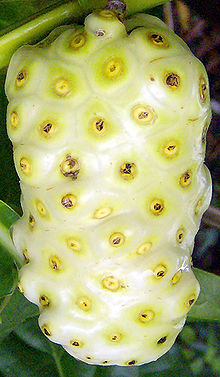Morinda citrifolia
| Morinda citrifolia | |
|---|---|
 | |
| Leaves and fruit | |
| Scientific classification | |
| Kingdom: | Plantae |
| (unranked): | Angiosperms |
| (unranked): | Eudicots |
| (unranked): | Asterids |
| Order: | Gentianales |
| Family: | Rubiaceae |
| Genus: | Morinda |
| Species: | M. citrifolia |
| Binomial name | |
| Morinda citrifolia | |
Morinda citrifolia is a tree in the coffee family, Rubiaceae. Its native range extends through Southeast Asia and Australasia, and the species is now cultivated throughout the tropics and widely naturalised.
English common names include great morinda, Indian mulberry, noni, beach mulberry, and cheese fruit.
Growing habitats
M. citrifolia grows in shady forests, as well as on open rocky or sandy shores. It reaches maturity in about 18 months, then yields between 4 and 8 kg (8.8 and 17.6 lb) of fruit every month throughout the year. It is tolerant of saline soils, drought conditions, and secondary soils. It is therefore found in a wide variety of habitats:volcanic terrains, lava-strewn coasts, and clearings or limestone outcrops, as well as in coralline atolls. It can grow up to 9 m (30 ft) tall, and has large, simple, dark green, shiny and deeply veined leaves.
The plant bears flowers and fruits all year round. The fruit is a multiple fruit that has a pungent odour when ripening, and is hence also known as cheese fruit or even vomit fruit. It is oval in shape and reaches 10–18 centimetres (3.9–7.1 in) size. At first green, the fruit turns yellow then almost white as it ripens. It contains many seeds. It is sometimes called starvation fruit. Despite its strong smell and bitter taste, the fruit is nevertheless eaten as a famine food and, in some Pacific islands, even a staple food, either raw or cooked. Southeast Asians and Australian Aborigines consume the fruit raw with salt or cook it with curry. The seeds are edible when roasted.
M. citrifolia is especially attractive to weaver ants, which make nests from the leaves of the tree. These ants protect the plant from some plant-parasitic insects. The smell of the fruit also attracts fruit bats, which aid in dispersing the seeds. A type of fruit fly, Drosophila sechellia, feeds exclusively on these fruits.
Nutrients and phytochemicals
M. citrifolia fruit powder contains carbohydrates and dietary fibre in moderate amounts.These macronutrients evidently reside in the fruit pulp, as M. citrifolia juice has sparse nutrient content. The main micronutrients of M. citrifolia pulp powder include vitamin C, niacin (vitamin B3), iron and potassium. Vitamin A, calcium and sodium are present in moderate amounts. When M. citrifolia juice alone is analyzed and compared to pulp powder, only vitamin C is retained in an amount that is about half the content of a raw navel orange. Sodium levels in M. citrifolia juice (about 3% of Dietary Reference Intake, DRI) are high compared to an orange, and potassium content is moderate. The juice is otherwise similar in micronutrient content to a raw orange.
M. citrifolia fruit contains a number of phytochemicals, including lignans, oligo- and polysaccharides, flavonoids, iridoids, fatty acids, scopoletin, catechin, beta-sitosterol, damnacanthal, and alkaloids. Although these substances have been studied forbioactivity, current research is insufficient to conclude anything about their effects on human health. These phytochemicals are not unique to M. citrifolia, as they exist in various plants.
Gastronomic uses
In Thai cuisine, the leaves (known as bai-yo, ใบยอ) are used as a green vegetable and the fruit (luk-yo, ลูกยอ) is added as a salad ingredient to some versions of somtam.
Traditional medicine
The green fruit, leaves, and root/rhizomes were traditionally used in Polynesian cultures to treat menstrual cramps, bowel irregularities, diabetes, liver diseases, and urinary tract infections.
In Traditional Chinese Medicine, the roots, known as Ba Ji Tian, have been used to treat abdominal pain, impotence, andmenstrual disorders.
Consumer uses
Morinda bark produces a brownish-purplish dye that may be used for making batik. In Hawaii, yellowish dye is extracted from its roots to dye cloth.
There have been recent applications for the use of M. citrifolia seed oil which contains linoleic acid, possibly useful when applied topically to skin, e.g., for anti-inflammation, acne reduction, or moisture retention.



Tidak ada komentar:
Posting Komentar